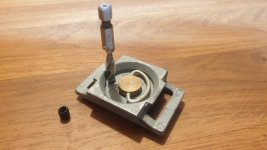OK, so I basically hate my tripod....worse £300 I've ever spent. But the worst annoyance is the availability of the little 'screw peg' that stops the telescope rotating off the attachment plate. Does anyone know where I can buy these little bugger - or use something completely different - to stop this from continually happening?? Looking online i can only buy them as part of a new plate set? So frustrating
I tend to agree with the sentiments above that Manfrotto RC2 quick release system isn’t terribly good. Lots of people complain of plates twisting and not remaining tightly screwed on to cameras and scopes-and consequently leading to frustration!
Manfrotto dominated the birding tripod market from the 1980s here in the UK, and it seems most birders here still use their gear. Same in Europe and N America I presume?
Familiarity breeds familiarity and all that, but that’s changing now in favour of the Arca Swiss standard which is infinitely better IMO, though, as Hermann implies, there are issues there too e.g. with mis-matching of plates and clamps from different manufacturers! They don't all work together perfectly as you would expect, but in my experience the majority do.
Personally I don’t think the Manfrotto plates are inherently bad. It’s just that the method of preventing twisting once screwed onto the plate is flawed.
Also there is no way with the RC2 plates to slide the camera or scope forward or back in the clamp to balance the system - important if you digiscope, for example.
If you are determined to stick with Manfrotto plates, this is what I would do. I’ve done this to a number of camera plates (mainly Arca type). It works well and is really simple & cheap.
In a nutshell, you cut a 1/4” 20 UNC thread into the existing hole in the Manfrotto plate (not the central hole for the camera screw). In fact you could probably do the same to each of the 3 existing holes in the plate.
Then use a 1/4” 20 grub screw instead of your anti-twist pin (the one you’ve lost)
It’s that simple!
The benefits are that it should be possible to locate the cone points of the grub screws in the existing holes in the scope foot - in particular the two holes above and below the larger one for the camera screw.
I assume that the holes in the Q/R plate will match up with those in the scope’s foot? They should, but I’m not sure if they all exactly correspond? so worth measuring accurately before going ahead…
I personally bought a drill bit that also cuts a 1/4 20 UNC thread, so that any holes I drill will also accept threaded grub screws. 1/4” 20 UNC is the size of most camera screws, so they are the ones I bought (cost about £5 for a bag of 10 from everyone’s favorite online retailer!
The drill bit I own is a DeWalt, and is illustrated in the first and second pictures. You can see it standing upright in the existing un-threaded hole in the Manfrotto plate. The drill part of the bit at the tip fits quite snugly into the hole with just a tiny bit of movement to allow it to spin freely, and I assume as this is an older Manfrotto RC2 plate, that the diameter will be the same size as the 3 holes in your plate (but do check!).
If so then all you would need to do is put the drill bit in your cordless drill and follow through in order to cut threads into the hole. You could probably even do this by hand, by putting the hex-shaped shank of the drill bit into the handle of a screwdriver (the type that accept interchangeable driver bits).
The second picture shows the DeWalt drill bit with integrated thread cutter, alongside a grub screw that fits inside the hole it creates. These grub screws are about 5mm long. Ideally they should be able to locate within the hole in the plate and not protrude above it once installed. The ones I have require an imperial allen key to tighten them in place.
I paid £17 for the drill bit (again from Amazon UK) but cheaper ones were available. A cheaper alternative still, would be something like the 1/4” 20 threading tap in pic 3, which has a 5mm diameter shank so it might fit inside a cordless drill chuck. An important point is that the latter would only cut threads in an existing hole of suitable size, whereas the DeWalt can drill and cut new threaded holes in a camera plate-wherever you need them to be.













